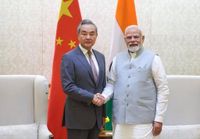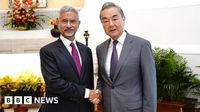In a region long defined by border standoffs and mutual suspicion, a fragile but unmistakable thaw is underway between Asia’s two largest powers. On August 18 and 19, 2025, Chinese Foreign Minister Wang Yi arrived in Delhi for a pivotal two-day visit, meeting with Indian Foreign Minister S Jaishankar, National Security Adviser Ajit Doval, and Prime Minister Narendra Modi. The atmosphere, once frosty after the deadly Galwan Valley clashes in 2020, has shifted—at least for now—towards dialogue and cautious optimism.
According to BBC News, Wang Yi set the tone for the visit by declaring, "India and China should view each other as partners rather than adversaries or threats." This sentiment was echoed by Jaishankar, who noted that both countries were striving to "move ahead from a difficult period in our ties." The two sides discussed a wide range of issues, from border management and trade to pilgrimage access and river data sharing—small steps, perhaps, but symbolically significant in the wake of years of tension.
The backdrop to this diplomatic outreach is as much global as it is local. The United States, under President Donald Trump, has recently imposed a 50% tariff on Indian imports as punishment for India’s ongoing purchases of Russian oil and weapons. White House Trade Advisor Peter Navarro, writing in The Financial Times, accused India of "cosying up to both Russia and China," and warned, "If India wants to be treated as a strategic partner of the U.S., it needs to start acting like one." With Washington’s tone hardening, Delhi’s overtures to Beijing—and to Moscow—take on a new urgency.
As reported by The Tribune, Wang Yi’s three-day visit marks the first high-level interaction between the two countries since the Galwan Valley incident in 2020. The fact that both sides are now contemplating a future as "partners and not adversaries" is, in itself, a dramatic shift. This rapprochement is expected to set the stage for Prime Minister Modi’s upcoming summit with Chinese President Xi Jinping later this month at the Shanghai Cooperation Organisation (SCO) summit—his first visit to China in seven years.
But what’s driving this change? According to Reuters and The Economic Times, China has pledged to address three of India’s most pressing economic concerns: access to fertilisers, rare earths, and tunnel boring machines. During his meetings in Delhi, Wang Yi assured Jaishankar that China had lifted export curbs on all three, a move designed to smooth over trade frictions and build trust. "There has been an upward trend. Borders have been quiet. There has been peace and tranquillity," Doval told Wang Yi as they opened their talks. "Our bilateral engagements have been more substantial."
This isn’t just diplomatic window-dressing. India, despite having the world’s fifth-largest rare earth reserves (an estimated 6.9 million metric tons), lacks the capacity to produce the high-tech magnets needed for everything from smartphones to electric cars. As of June 2025, Chinese rare earth magnet exports to India were still down 58% compared to January, according to Chinese customs data. By promising to lift export curbs, Beijing is offering a lifeline to Indian industry—one that comes with both economic and strategic strings attached.
As China Global South notes, these latest engagements are part of a broader diplomatic effort to ease tensions. Since the two countries agreed to new patrolling arrangements along their disputed Himalayan border in October 2024, there has been a marked reduction in incidents and a slow resumption of normalcy. Pilgrimages for Indian citizens to key sites in Tibet have resumed, visa services for Chinese tourists are back on, and talks to reopen border trade through designated passes are underway. There are even reports that direct flights between India and China could resume later this year—small but meaningful steps toward restoring the connective tissue of people-to-people ties.
Yet, as The Tribune points out, Delhi’s strategic alignment with the United States and its membership in the QUAD security grouping will continue to complicate its relationship with Beijing. The diplomatic dance between India, China, and the US is delicate; every step forward with one partner risks a misstep with another. The region’s peace, the paper argues, depends on India’s willingness to engage not just with China, but also with Pakistan—another long-standing rival and China’s close ally. Wang Yi’s itinerary reflects this: after his Delhi stop, he was scheduled to fly to Islamabad for the sixth Pakistan-China Strategic Dialogue, a reminder that regional stability is a multi-sided puzzle.
For all the positive rhetoric, the road ahead is anything but straightforward. As Jaishankar put it, "We seek a fair, balanced and multi-polar world order, including a multipolar Asia." He added, "Reformed multilateralism is also the call of the day. In the current environment, there is clearly the imperative of maintaining and enhancing stability in the global economy as well." These are lofty goals, and achieving them will require more than handshakes and photo ops.
Still, the symbolism of this week’s meetings should not be underestimated. Modi, after his session with Wang Yi, posted an image of their handshake with the caption, "Since my meeting with President Xi in Kazan last year, India-China relations have made steady progress guided by respect for each other’s interests and sensitivities. Stable, predictable, constructive ties between India and China will contribute significantly to regional as well as global peace and prosperity."
The Deccan Herald’s evening brief captured the mood succinctly: the thaw in India-China ties comes at a moment of heightened US tariff threats, and is part of a broader recalibration in Delhi’s foreign policy. Whether this spirit of cooperation will prove durable—or is merely a pause before the next round of rivalry—remains to be seen. But for now, both sides seem willing to test the waters of partnership.
As Wang Yi told his Indian hosts, "The stable and healthy development of China-India relations is in the fundamental interests of the two countries’ people." The coming weeks, with Modi’s trip to China and the resumption of high-level dialogues, will reveal whether this new chapter is truly beginning—or if old grievances will once again rise to the surface. The stakes, for India, China, and the region, couldn’t be higher.


